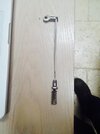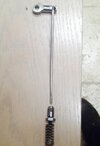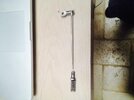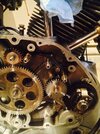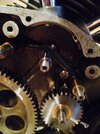Well genedn, I am not sure that I understand exactly what you are saying. Am I correct that you have zero clearance at top dead centre and then when you rotate the engine there are some places where the clearance of the tappet on top of the pushrod increases so that there is now slop or play at that point? If that is correct then something is wrong. You should see the pushrod stay still until the cam starts to push the cam follower upwards, then the rocker lifts, the valve opens and progressively opens more until eventually the valve starts to close and finally the clearance should return to zero. For the whole of the time the valve is open it should be impossible to rotate the pushrod in its top and bottom cups. If play is occurring can you tell us at what stage of the cam rotation it is happening, e.g. end of lift, start of lift etc. Remember, with your timing cover off you can see where the cam follower is in relation to where it is touching the cam. If my interpretation of your problem is correct then you could have a malformed cam or the cam is not timed up properly to be fully closed at TDC. Just how much clearance are you getting; a thou, ten thou or what?

